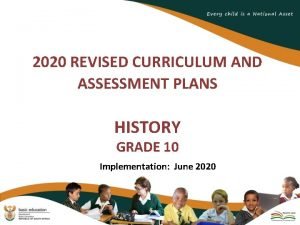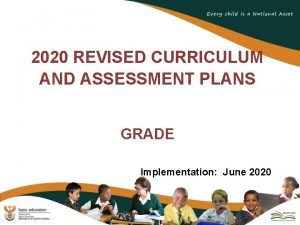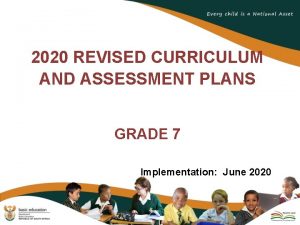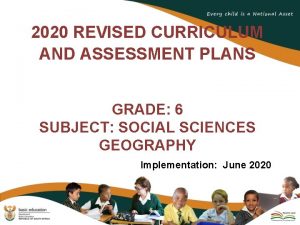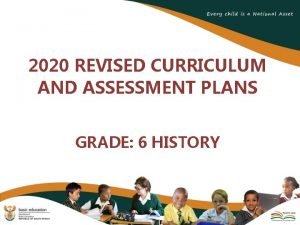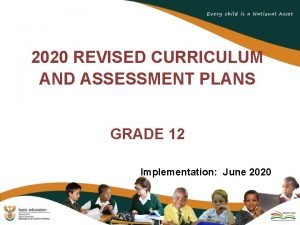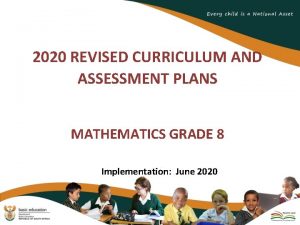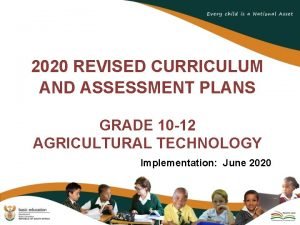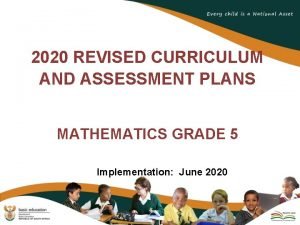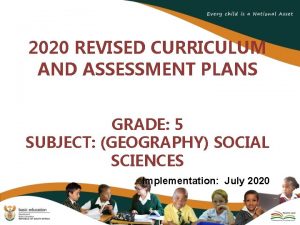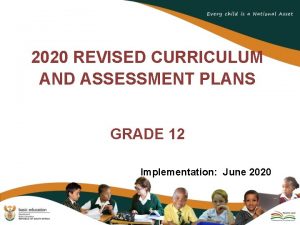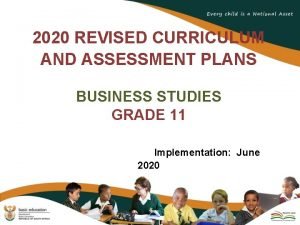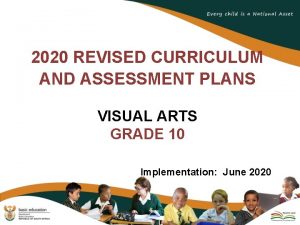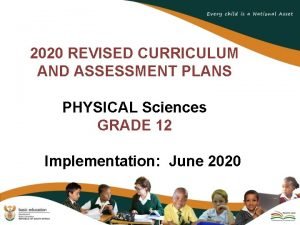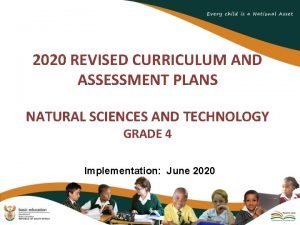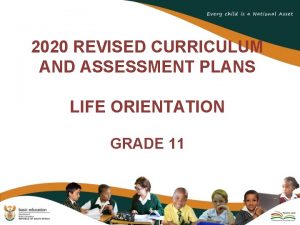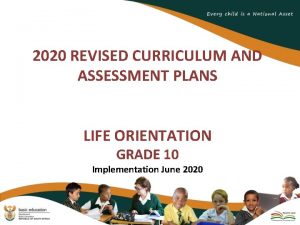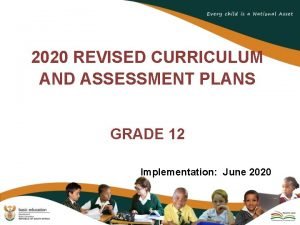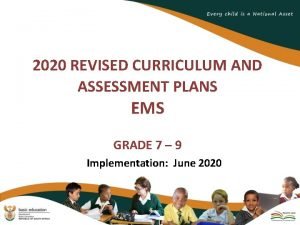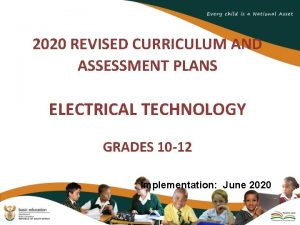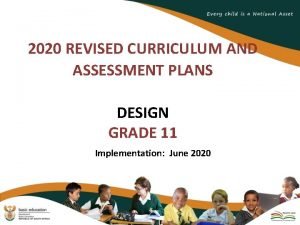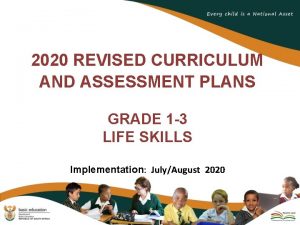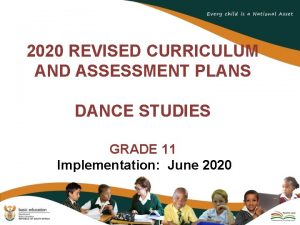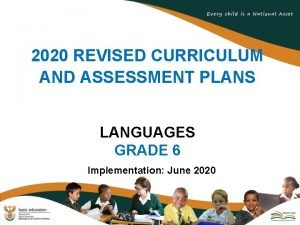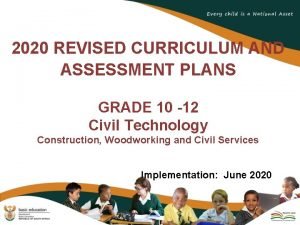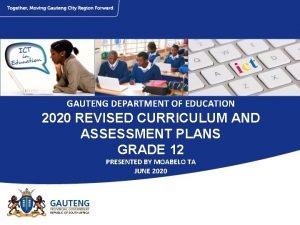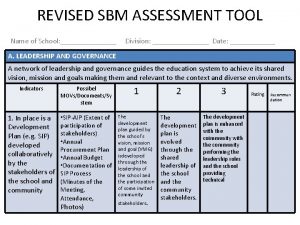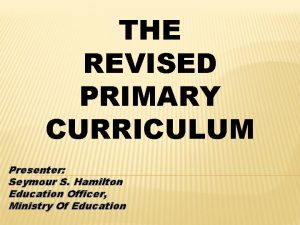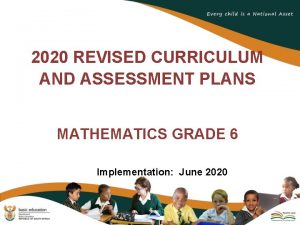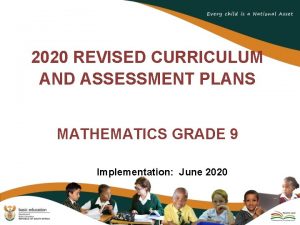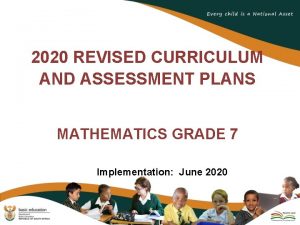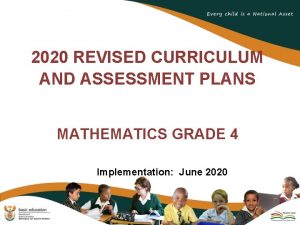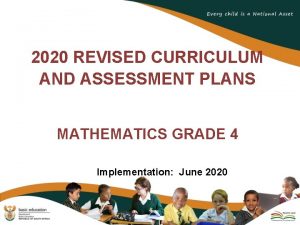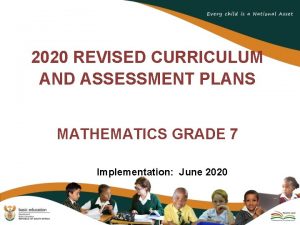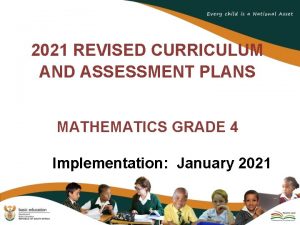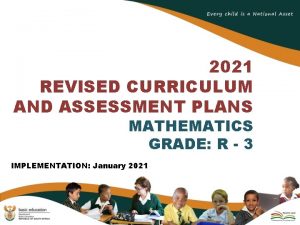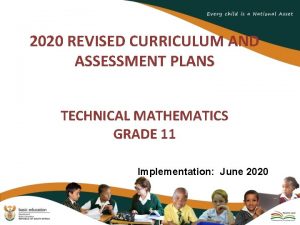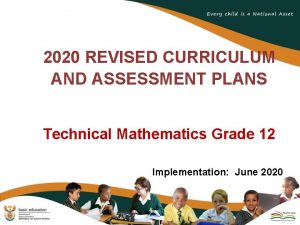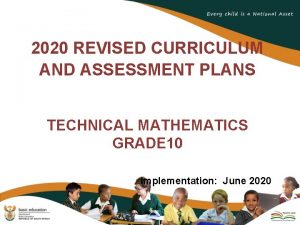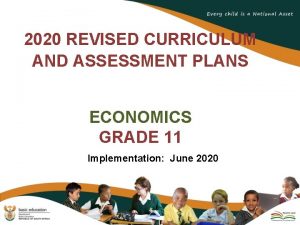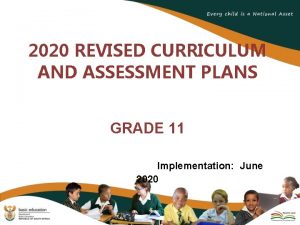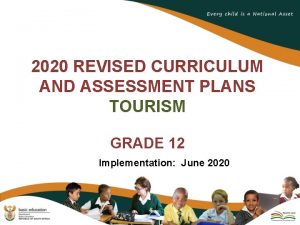2020 REVISED CURRICULUM AND ASSESSMENT PLANS MATHEMATICS GRADE






























- Slides: 30

2020 REVISED CURRICULUM AND ASSESSMENT PLANS MATHEMATICS GRADE 2 Implementation: June 2020

Presentation Outline 1. Purpose 2. Amendments to the Content Overview for the Phase; 3. Amendments to the Annual Teaching Plan; 4. Amendments School Based Assessment (SBA) 5. Conclusion

1. Purpose • To mediate the amendments of the trimmed and re-organised 2020 Annual Teaching Plan including School Based Assessment for Mathematics, Grade 2 for implementation in June 2020 as stipulated in Circular S 2 of 2020. • To ensure that meaningful teaching proceeds during the remaining teaching time as per the revised school calendar. • To assist teachers with guided pacing and sequencing of curriculum content and assessment.

1. Purpose (continued) • To enable teachers to cover the essential core content /skills in each grade within the available time. • To assist teachers with planning for the different forms of assessment. • To ensure learners are adequately prepared for the subsequent year/s in terms of content, skills, knowledge, attitudes and values

2. Amendments to the Content Overview for the Phase

Summary: Amendments to the Content Overview for the Phase Topic Grade 1 Grade 2 Grade 3 1. 1 Count objects No change Number range reduced to 180 Number range reduced to 800 1. 2 Count forward and backwards Number range reduced to 80 Number range reduced to 180 Number range reduced to 800 1. 3 Number symbols and number names Number range reduced to: read number symbols 1 to 80 write number symbols 1 to 20 Number range reduced to: read number symbols 1 to 80 write number symbols 1 to 180 read number names 1 to 10 write number names 1 to 10 read number names 1 to 100 write number names 1 to 100 Number range reduced to: read number symbols 1 to 800 write number symbols 1 to 800 read number names 1 to 800 write number names 1 to 800

Summary: Amendments to the Content Overview for the Phase…(2) Topic Grade 1 1. 4 No change Describe, compare and order numbers Grade 2 Grade 3 Number range reduced from 99 to reduced from 999 75 to 800 1. 5 Place value Number range reduced from 19 to reduced from 999 15 75 to 800 1. 6 Problem solving techniques No changes, these are problem solving techniques applied when solving problems in context. 1. 7 Addition and subtraction Number range reduced from 20 to reduced from 999 15 75 to 800

Summary: Amendments to the Content Overview for the Phase…(3) Topic Grade 1 Grade 2 Grade 3 1. 8 Repeated addition Number range No change reduced from 20 to reduced from 50 to 15 40 1. 9 Grouping and sharing leading to division Number range No change reduced from 20 to reduced from 50 to 15 40 1. 10 Sharing leading to fractions No change 1. 11 Money No change 5 Cents coin excluded, otherwise there is no change across the phase.

Summary: Amendments to the Content Overview for the Phase…(4) Topic Grade 1 Grade 2 Grade 3 1. 12 Techniques (methods or strategies) No changes, these are problem solving techniques applied in context-free calculations 1. 13 Addition and subtraction Number range reduced from 20 to reduced from 999 15 75 to 800 1. 14 Repeated addition leading to multiplication Number range No change reduced from 20 to 15 1. 15 Division No change

Summary: Amendments to the Content Overview for the Phase…(5) Topic 1. 16 Mental Mathematics 1. 17 Fractions 2. 1 Geometric patterns 2. 2 Number patterns Grade R Grade 1 Grade 2 Grade 3 Integrated across all topics. No change but it is recommended that Geometric Patterns (2. 1) be done to emphasise the attributes of 3 -D objects and 2 -D shapes (3. 3) Number range reduced from 100 to 80 200 to 180 1000 to 800 To save time it is recommended that Number patterns (2. 2) can be done to emphasise counting backwards and forwards (1. 2) in multiples of any given number in numbers, operations and relationships.

Summary: Amendments to the Content Overview for the Phase…(6) Topic Grade 1 Grade 2 Grade 3 3. 1 Position, orientation and views Removed, the skill is not lost as this is also covered in Languages and in Life Skills. 3. 2 3 -D Objects No change Special care should be exercised to enforce Social Distancing when using concrete materials. 3. 3 2 -D Shapes No change Special care should be exercised to enforce Social Distancing when using concrete materials. 3. 4 Symmetry No change 4. 1 Time No change. Time is dealt with continuously during whole class teaching time

Summary: Amendments to the Content Overview for the Phase…(7) Topic Grade 1 4. 2 Length No change 4. 3 Mass Removed Grade 2 Removed Grade 3 Removed NB: Length will be taught only in Grades R and 1 for term 3 and term 4 of 2020. Special care should be exercised to enforce Social Distancing when measuring , be it formal or informal measuring. No change Removed NB: Mass will be taught only in Grade 2 for term 3 and term 4 of 2020. Special care should be exercised to enforce Social Distancing when measuring , be it formal or informal measuring. 4. 4 Capacity/ Volume Removed No change NB: Capacity/Volume will be taught only in Grade 3 for term 3 and term 4 of 2020. Special care should be exercised to enforce Social Distancing when measuring , be it formal or informal measuring.

Summary: Amendments to the Content Overview for the Phase…(8) Topic Grade 1 Grade 2 Grade 3 4. 5 Perimeter Removed 4. 6 Area Removed 5. 1 Collect and sort objects No changes. It is recommended that: 1. The attendance register and weather chart that are done daily be used as an opportunity 5. 2 for working with Data Handling. Represent sorted 2. In NOR, learners are expected to collection of physically collect, count and compare objects which will form a base for Data Handling 3. Theses skills should be infused In Space and Shape where sorting is done according 5. 3 Discuss and to a specific attribute (colour, size, shape) report on sorted 4. When doing measurement when you collection of compare quantity objects

Summary: Amendments to the Content Overview for the Phase…(9) Topic 5. 4 Collect and organise data 5. 5 Represent data 5. 6 Analyse and interpret data Grade 1 Grade 2 Grade 3 No change. It is recommended that: 1. The attendance register and weather chart that are done daily be used as an opportunity for working with Data Handling. 2. In NOR, learners are expected to physically collect, count and compare objects which will form a base for Data Handling 3. Theses skills should be infused In Space and Shape where sorting is done according to a specific attribute (colour, size, shape) 4. In Measurement when comparing quantities.

3. Amendments to the Annual Teaching Plan

Summary: Reorganisation of content topics • Mental Mathematics to be integrated throughout. • Related topics may to be taught to support one another and not in isolation – Counting forward and backwards (1. 2) and number patterns (2. 2) are addressing the same skill, hence reorganised. – PATTERNS and DATA HANDLING to be integrated with NOR and Space and Shape – After solving problems in context (1. 7 – 1. 9) and learners demonstrate an understanding the skills, then context free calculations can be done (1. 12 – 1. 14).

Summary: Amendment to the weighting of content topics – The attributes of 3 -D objects (3. 2) and 2 -D shapes (3. 3) can be used to teach geometric patterns (2. 1) – Attributes of 3 -D objects (3. 2) and 2 -D shapes (3. 3) can be used to assess skills in Data handling (3. 1 - 3. 3) – Knowledge acquired while measuring (informally) may be used to address Data Handling skills (5. 4 – 5. 6)

Summary: Amendment to the weighting of content areas The weighting of mathematics content areas serves two primary purposes: Firstly, the weighting gives guidance on the amount of time needed to address the content within each content area adequately. Secondly, the weighting gives guidance on the spread of content in assessment.

Summary: Amendment to the weighting of content areas • The weighting of content areas remains unchanged. Grade CA 1: Numbers, Operations and Relationships CA 2: Patterns, Functions and Algebra CA 3: Space and Shapes (Geometry) CA 4: Measurement CA 5: Data Handling 1 65% 10% 11% 9% 5% 2 60% 13% 12% 5% 3 58% 10% 13% 14% 5%

Summary: Content/Topics Amended Term 3 and 4 Content/Topics 1. 1 Count objects 1. 2 Count forward and backwards Amendment Reduced Number range reduced from 180 to 150 in term 3 and also reduced from 200 to 180 in term 4 1. 3 Number names and symbols 3 and 4 1. 4 Describe, order and compare numbers 1. 5 Place Value Reduced Number range reduced from 75 to 50 in term 3 and also reduced from 99 to 75 in term 4

Summary: Content/Topics Amended…(2) Term Content/Topics Amendment 3 and 4 Reduced 1. 7 Addition and subtraction Number range reduced from 75 to 50 in term 3, and from 99 to 1. 13 Addition and subtraction 75 in term 4. 3 and 4 1. 8 Repeated addition leading to multiplication 1. 9 Grouping and sharing leading to division Reduced Number range reduced from 40 to 30 in term 3, and from 50 to 40 in term 4.

Summary: Content/Topics Amended…(3) Term Content/Topics Amendment 1. 11 Money Removed Identify 5 C coin 3 and 4 1. 12 Techniques 1. 13 Addition and subtraction 1. 14 Repeated addition leading to multiplication Reduced Symbolic representation (context free calculations) will be taught as required with reduced number ranges as in 1. 7 -1. 9 (from the known to the unknown) 3 and 4 1. 16 Mental Mathematics Reorganised Integrated into all topics 3 and 4 2. 1 Geometric patterns Reorganised Attributes of 3 -D objects (3. 2) and 2 D shapes (3. 3) used to teach geometric patterns 3 and 4

Summary: Content/Topics Amended…(4) Term 3 and 4 3 4 Content/Topics 2. 2 Number patterns 3. 1 Position, orientation and views 3. 2 3 -D objects Amendment Reorganised Using multiples to count forward and backwards in 1. 2 Reduced Number range reduced from 180 to 150 in term 3 and from 200 to 180 in term 4 Removed Covered in Languages and Life Skills Removed Covered in the same way as in term 3

Summary: Content/Topics Amended…(5) Term 4 3 and 4 Content/Topics 4. 2 Length 4. 4 Capacity Amendment Removed Taught in Grades R and 1 for the remaining terms in 2020 Removed Taught in Grade 3 for the remaining terms in 2020 5. 4 Collect and organise Reorganised Data Handling skills have been data integrated in other topics e. g. 33 and 4 5. 5 Represent data D objects, 2 -D shapes, counting 5. 6 Analyse and etc. interpret data

4. Amendments School Based Assessment (SBA)

School Based Assessment • The main purpose of School Based Assessment (SBA) is to enable the teacher to make decisions that influence a learner’s progress positively. • It should therefore be viewed as a fundamental practice that is embedded in the teaching and learning process. • It is 100% continuous.

Programme of Assessment • The Programme of Assessment (POA) will comprise of only one Assessment Task (AT) per subject which will be done per term in Grades 1 to 3. • An Assessment Task covers all Content Areas in Mathematics and comprises of Oral, Practical and Written activities, thus promoting assessment of learning. • Teachers teaching the same grade must collaborate and jointly develop assessment activities which will allow learners to demonstrate their understanding of the concepts/content knowledge/skills and decide on the final date by which these activities will be completed.

Summary: Revised Programme of Assessment Grad e Subjects 1 HL 1 1 1 1 FAL 1 1 1 1 MATHS 1 1 1 1 LIFE SKILLS 1 1 1 1 HL 1 1 FAL 1 1 MATHS 1 1 LIFE 1 1 2 3 Term 1 Term 2 Term 3 Term 4

Conclusion • Cognisance was taken of the holistic development of the child. • The limited teaching time necessitated a reduction in the number range and the integration of concepts across the content areas. • If taught well this will support a deeper insight of the concepts taught. • Good number sense is a key building block for further Maths development in the primary school. • Number sense is an intuitive process that is internalised by the learner once the learner understands the concept taught. • Good maths methodology rests with Piaget’s 3 types of knowledge – Physical, Cognitive and Social – this will ensure the learner understands before expected to record the mathematical thinking.

Contact Details Name: Sindiswa Mcosana CES: Mathematics Foundation Phase Department of Basic Education Tel: 012 357 3197 Email: Mcosana. s@dbe. gov. za
 Grade 7 geography term 1
Grade 7 geography term 1 2020 revised curriculum and assessment plans grade 6
2020 revised curriculum and assessment plans grade 6 2020 revised curriculum and assessment plans grade 7
2020 revised curriculum and assessment plans grade 7 2020 revised curriculum and assessment plans grade 7
2020 revised curriculum and assessment plans grade 7 2020 revised curriculum and assessment plans grade 7
2020 revised curriculum and assessment plans grade 7 2020 revised curriculum and assessment plans
2020 revised curriculum and assessment plans 2020 revised curriculum and assessment plans grade 6
2020 revised curriculum and assessment plans grade 6 Revised curriculum 2020
Revised curriculum 2020 2020 revised curriculum and assessment plans
2020 revised curriculum and assessment plans 2020 revised curriculum and assessment plans
2020 revised curriculum and assessment plans 2020 revised curriculum and assessment plans
2020 revised curriculum and assessment plans Physical features of south africa grade 5
Physical features of south africa grade 5 2020 revised curriculum and assessment plans
2020 revised curriculum and assessment plans 2020 revised curriculum and assessment plans
2020 revised curriculum and assessment plans 2020 revised curriculum and assessment plans
2020 revised curriculum and assessment plans 2020 revised curriculum and assessment plans
2020 revised curriculum and assessment plans Revised curriculum 2020
Revised curriculum 2020 Revised programme of assessment 2020
Revised programme of assessment 2020 2020 revised curriculum and assessment plans
2020 revised curriculum and assessment plans 2020 revised curriculum and assessment plans
2020 revised curriculum and assessment plans 2021 revised curriculum and assessment plans
2021 revised curriculum and assessment plans Grade 9 ems business plan project
Grade 9 ems business plan project Electrical technology grade 12
Electrical technology grade 12 2020 revised curriculum and assessment plans
2020 revised curriculum and assessment plans Conclusion of life skills
Conclusion of life skills 2021 revised curriculum and assessment plans
2021 revised curriculum and assessment plans Revised annual teaching plans 2020
Revised annual teaching plans 2020 National revised teaching plans grade 10
National revised teaching plans grade 10 Gde strategic goals
Gde strategic goals Sbm movs
Sbm movs Revised primary curriculum grade 1-3
Revised primary curriculum grade 1-3


